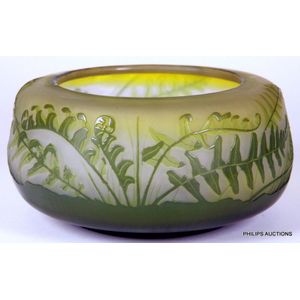Enamelled Art Nouveau Pill Box
You must be a subscriber, and be logged in to view price and dealer details.
Subscribe Now to view actual auction price for this item
When you subscribe, you have the option of setting the currency in which to display prices to $Au, $US, $NZ or Stg.
- Art Nouveau Period - The Art Nouveau period was a cultural movement that emerged in the late 19th century, and was characterized by its emphasis on natural forms, flowing lines, and a decorative, ornamental style. Art Nouveau was a reaction against the ornate and heavily stylized designs of the previous era, and sought to create a new, more organic aesthetic.
Art Nouveau was characterized by its use of sinuous, curving lines, as well as a focus on natural elements such as flowers, vines, and other organic shapes. Art Nouveau designers sought to create a total work of art, in which every element of a building or object was designed to be harmonious with the overall design.
Some of the most iconic examples of Art Nouveau design include the Paris Metro entrances designed by Hector Guimard, the works of the artist Alphonse Mucha, and the architecture of Victor Horta in Brussels.
The Art Nouveau period was at its peak between 1890 and 1910, but began to decline in popularity by the start of World War I. However, Art Nouveau remains an important influence on design and art to this day, and continues to be celebrated for its emphasis on natural forms and decorative style. - Guilloche - A form of classical decoration consisting of a repeating ornament of interlacing curved bands, sometimes forming circles, and further decorated with rosettes or other flower forms.
The name is derived from the inventor, French engineer Guillot, who invented a mechanical method of inscribing fine repeating patterns on to metallic surfaces.
On enamelled items with guilloche decoration, the surface is firstly engraved with the repeating pattern, and then covered with several layers of enamel, each of which is fired.
Where the item has not been enamelled the form of decoration is usually called "engine turned".
This item has been included into following indexes:
Visually similar items

Modern Moorcroft circular box & cover Saadian pattern, 2001, 16 cm diameter, boxed

An Art Nouveau cameo glass bowl by Emile Galle, circa 1900, a bowl of compressed form with an inverted collar, decorated in the round with fern leaves and fronds in shades of green upon a frosted paler green ground, having a polished rim and ground pontil,

Melrose Ware green drip glaze Gumnut vase stamped to the base 'Melrose Ware Australia'. Height 25.5 cm

A small Royal Doulton 'Kia Ora' jardiniere, decorated with tiki, masks, spiral motifs and 'Kia Ora' plaques on a mottled blue ground, a small band of darker blue encircles the foot. Diameter 16 cm. Height 11.5 cm
